Key Takeaways
- A UTV, also known as a Utility Terrain Vehicle or SxS, is a versatile off-road vehicle that can carry four to six passengers, making it ideal for both heavy-duty tasks and recreational activities.
- UTVs, designed for work and comfort, can carry more passengers and gear, offer more customization, and have better safety features than ATVs, which are mainly for solo use, recreation, and racing, with higher speeds but less capacity and safety features.
- UTVs are the optimal choice for farming, heavy-duty work, group touring, and comfort.
- Different types of UTVs include Utility UTVs, Sport UTVs, Youth UTVs, and Off-Road UTVs.
- Well-known UTV brands in the market include Polaris, Honda, Can-Am, Yamaha, Arctic Cat, and John Deere.
What Is A UTV?
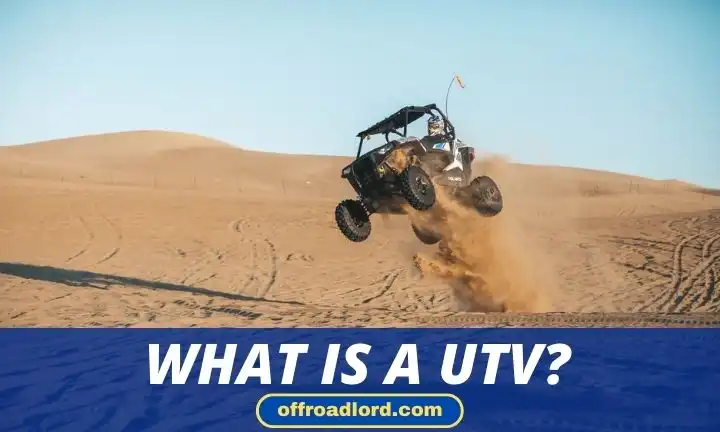
A UTV, or Utility Terrain Vehicle, is an off-road vehicle great for work or fun. People often call it a Utility Task Vehicle or SxS (Side-by-Side) because it can carry four to six passengers. This makes UTVs bigger and more useful for tough jobs and carrying more people compared to smaller ATVs.
UTVs are driven like cars, with a steering wheel, gas pedal, and brake pedal. They also have a cabin to keep riders safe, which is really handy for all kinds of outdoor tasks and adventures.
What Makes a UTV Different From an ATV?
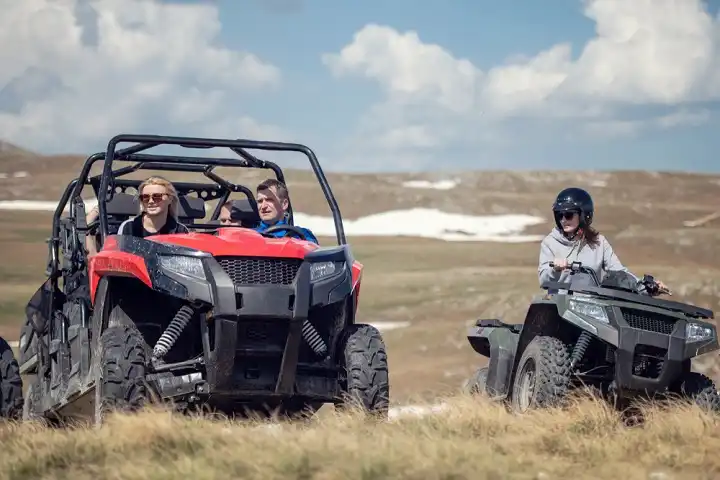
- Primary Use: UTVs are primarily used for work, making them better suited for heavy-duty tasks like farming, plowing, construction work, hauling, hunting, camping, as well as fun and adventures. They offer a combination of utility and recreation. ATVs, on the other hand, are primarily used for riding trails and racing. They are more focused on recreational and sporting activities.
- Passenger Capacity: UTVs can accommodate 2-6 passengers, suitable for group tasks or family rides, while ATVs are primarily designed for solo riding, though some models can accommodate a passenger.
- Load Capacity: UTVs have a larger load-carrying capacity, ideal for more gear or equipment, whereas ATVs have a limited load capacity, less suited for transporting large amounts.
- Comfort: UTVs offer more comfort with features like a roof and doors, better for extended rides and harsh weather; ATVs lack these comforts, making them less ideal for long durations or bad weather. Nowadays, I’ve noticed that most brands have started producing UTVs with air conditioning, so for comfort, you can always count on UTVs.
- Customization Options: UTVs boast more extensive customization options than ATVs. You can tailor a UTV with various modifications like custom suspensions, fog lights, or even build a fully enclosed cab to enhance functionality and comfort. ATVs, while also customizable, generally have more limited options, focusing mainly on enhancements like suspension and tires.
- Safety: UTVs are more stable due to a longer wheelbase and have roll cages and safety belts for enhanced protection. ATVs, with a shorter wheelbase, have a higher risk of tipping over and lack significant safety features like roll cages.
- Storage Space: UTVs provide ample storage for essentials, tools, and gear, whereas ATVs have limited storage, mainly small toolboxes, not suitable for large items.
- Towing Capacity: UTVs have a higher towing ability, ranging from 1,500 to 3,000 lbs, suitable for heavy tasks. ATVs, in contrast, have a lower towing capacity, generally up to 1,000 lbs.
- Top Speed: UTVs have variable top speeds, up to 80-85 mph, depending on various factors. ATVs are generally faster, with potential top speeds up to 90 mph.
- Cost: UTVs are more expensive, requiring higher investment and maintenance costs. ATVs are more affordable, with lower maintenance costs.
- Maneuverability: UTVs, due to their larger size and weight, can be less maneuverable in tight spaces. ATVs, with their compact size, are more agile and suitable for narrow, challenging terrains.
- Fuel Efficiency: UTVs tend to have lower fuel efficiency due to their size and weight. ATVs, being smaller and lighter, generally offer higher fuel efficiency.
Understanding When UTVs Are the Best Choice
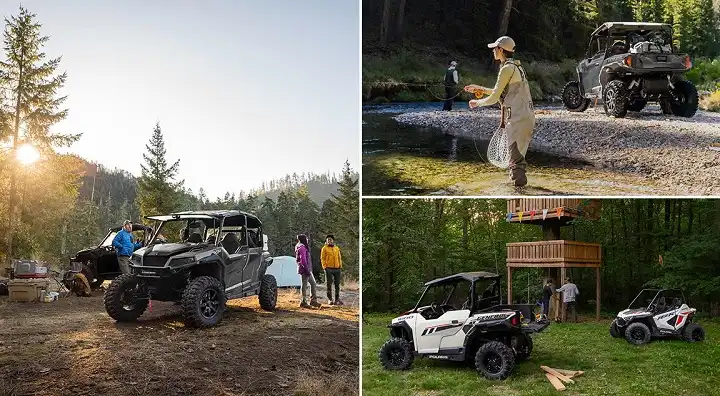
Best vehicle for your farm, period:
UTVs are perfect for farms. They have strong engines that can carry heavy things and tow equipment. With four-wheel drive, they can easily move through mud, snow, or rough land, so they’re great for any farm job.
They are incredibly versatile for farm work, capable of handling tasks like feeding livestock, cleanup duties, spreading seeds and fertilizer, working on fencing projects, and even catching calves.
UTVs with diesel engines are especially good for heavy work because they use fuel really well, which is great for moving big loads.
Here check out: Best UTVs for Farming
Comfort and adventure combined:
The comfort aspect in UTVs comes from their enclosed design, car-like seats, and availability of heating or cooling systems, making them suitable for all weather conditions.
UTVs are great for both work and fun because they have a high ground clearance and strong engines. This means they can easily go over rough land, which makes them perfect for exploring and riding on trails.
Another fact is, UTVs are also quiet, and if you choose one with a cabin, it reduces noise even more, making it easier on your ears.
Read more about: Quietest UTVs in 2025
When you need a customized work vehicle:
You can customize UTVs a lot. They can get different attachments for jobs like snow plowing or gardening by adding front loaders and more additional tools.
You can also make them more comfortable by adding windscreens or special seats. This is really useful for people who need their UTVs for more than just carrying stuff or getting around.
You do heavy duty work:
If you have heavy work like towing and hauling, UTVs are up to the task with their tough engines and strong frames. Many can tow up to 2,000 pounds and carry around 1,000 pounds.
Their sturdy build and powerful engines make them perfect for moving heavy farm gear or big game from hunting trips especially, the diesel UTVs are tougher and suited for heavy duty.
Your best companion for recreation:
UTVs are great for fun activities because they have lots of seats – up to six – perfect for group tours or hunting. They come with safety stuff like roll cages and seat belts to keep everyone safe.
Additionally, they have big cargo spaces for your hunting gear, game, or picnic stuff. That’s why they’re a top pick for outings with more people or equipment.
Different Types of UTVs
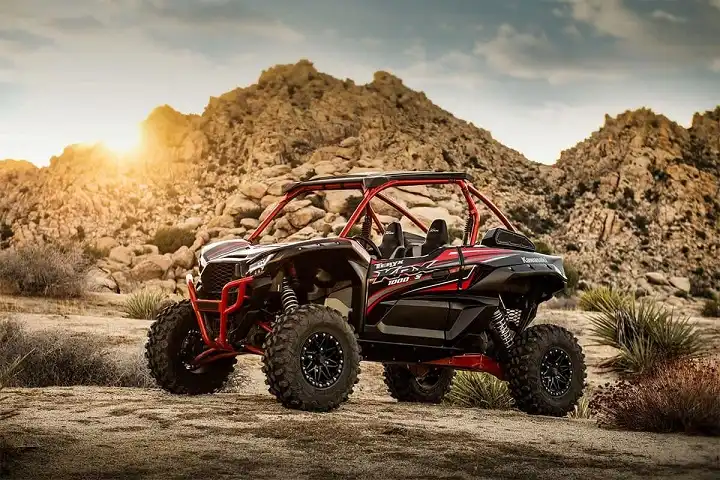
Utility UTVs
Utility UTVs are all-rounders, great for work tasks like farming, landscaping, or construction. They usually have medium-sized engines and come with handy features like cargo racks and winches to carry equipment.
These UTVs can do lots of different jobs and have plenty of room for tools or supplies. Because they can move across big, rough areas easily, many professionals prefer them.
Utility UTVs price starts from $14,500, and the price can go above $23,000 depending on the features. This type of UTV can be sized in large to small.
Read: Best 10 Small UTVs in 2025
The Kawasaki Mule, Honda Pioneer, and Polaris Ranger lineups include various well-known models of utility UTVs available today.
Sport UTVs
Sport UTVs are built for speed and they are the fastest UTVs out there. They have amazing suspension and can go really fast, which makes them great at handling tough rides.
They’re perfect for racing and trail riding. But because they focus on speed, they don’t have much space for cargo. Usually, they have two seats with safety belts.
The Can-Am Maverick X3, Polaris RZR Pro XP 4 SxS, Honda Talon 1000X-4 SE, and Kawasaki Teryx KRX® 1000 are the most popular sport UTV.
Sport UTVs range in price from entry-level models at $15,000-$18,000, to mid-range ones at $20,000-$25,000 with better engines and suspension, and can go above $30,000 for high-end models.
Youth UTVs
These UTVs are smaller and less powerful than adult UTVs, these are designed for children aged 16 and under.
They come packed with safety features like adjustable speed limiters, roll cages, and seat belts to keep young riders safe on any terrain.
Usually, youth UTVs have just two seats and no place for cargo, but some brands are now making them with a bit of storage space.
Popular youth UTVs include the Polaris Ranger 150 EFI, Blade 170, Trailmaster 150X, and Pitster Pro Avenger.
Top-of-the-line youth UTVs, equipped with electric motors and advanced features, can cost $3,200 or more.
Off-Road UTVs
Off-Road UTVs are made to handle rough and tough terrains. They usually have bigger tires and stronger suspension systems than other types of UTVs.
This makes them perfect for off-road fun like mudding, rock crawling, or going through wild, remote areas. They’re ideal for people who love serious off-roading and need a vehicle that can take on challenging, uneven ground.
Pros And Cons Of UTV
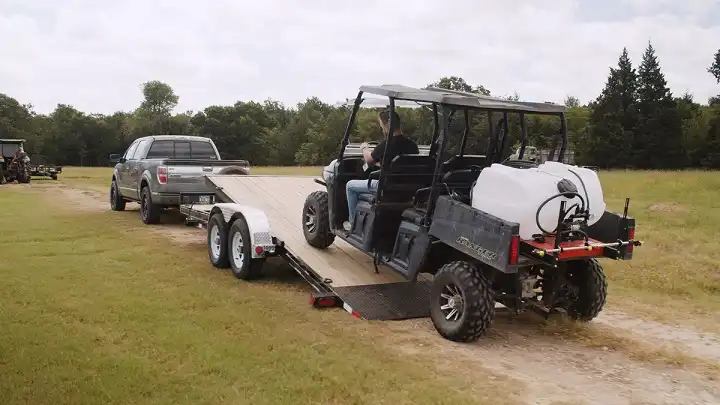
Pros of UTV:
- Durable and Reliable: UTVs are known for their exceptional durability and reliability in various terrains, crucial for off-roading vehicles.
- High Work Capacity: Powerful enough for heavy hauling and towing, with capacities up to 3,000 pounds.
- Recreational Uses: Accommodates 2-6 passengers, perfect for group tours and off-road adventures.
- Enhanced Safety: Safer design than ATVs, featuring roll cages, seat belts, and windshields.
- Variety for Specific Needs: Includes Sport UTVs for performance, Youth UTVs for safety, and Crew Cabs for touring.
- Easy to Maneuver: Steering wheel control makes them user-friendly, especially for car drivers.
- Enough Storage Capacity: They offer substantial storage capacity, beneficial for activities that require transporting goods or equipment.
- Car-Like Comfort: UTVs offer a more car-like experience with increased comfort and higher load capacity
Cons of UTV:
- UTVs are Expensive: UTVs are typically more expensive than ATVs, with average prices starting around $13,000, varying by features and type.
- Large Size and Parking Needs: Typical UTVs are 58 to 64 inches wide and 135 to 16 inches long; therefore, you need a bigger garage to store a UTV.
- Durability of Parts: While generally durable, some parts of UTV, especially plastic ones, may wear out or fade over time.
- Required Costly Repairs: Owning a UTV can be costly in terms of maintenance, with potential annual repair costs averaging around $500.
- Fuel Efficiency and AWD Concerns: AWD UTVs are less fuel-efficient than RWD models, and their maintenance is more complex and expensive.
- Handling Challenges: RWD UTVs, while better in dry conditions, may struggle on rough terrains, unlike AWD UTVs, which offer better traction but at a higher cost and maintenance requirement.
Leading UTV Brands in the Market
- Polaris: Polaris is an American off-road vehicle manufacturer that makes versatile UTVs that are a hit with off-roading fans. Some of their best-known models are the Polaris General XP 1000 Sport and Ranger XD 1500 Premium, famous for being reliable and performing well.
- Can-Am: Can-Am is famous for its high-performance UTVs, suitable for a variety of activities, from recreational rides to trail-riding. Popular models include the Defender XT and the Maverick X3 X DS Turbo RR. The Commander series, known for its versatility, is another favorite among Can-Am enthusiasts.
- Honda: As you already know, Honda is a Japanese brand so reliability is their key concern. Their UTVs are famous for working well on all kinds of terrains but they specialize in utility UTVs. Models like the Honda Pioneer 1000-4 Deluxe and the Honda Talon 1000X have strong engines, lots of seats, and good cargo space.
- Kawasaki: Kawasaki’s main UTV line is the Mule series, famous for being tough and versatile for both work and fun. Models like the Mule PRO-FXT Ranch Edition can carry and tow a lot. People often compare Kawasaki’s UTVs to heavy-duty pickup trucks because they’re strong and very useful.
- Yamaha: Yamaha combines spaciousness with power in their UTVs. Models like the Wolverine X2 850 and Viking EPS have good storage space and can tow a lot. They’re known for being comfortable to ride and are priced well in the market.
- John Deere: We all know John Deere stands for toughness, and that’s absolutely true. The Gator™ Utility Vehicles from John Deere are designed for challenging jobs, ranging from farming to construction. They offer models like the Mid-Size Gator™ Crossovers, which are both agile and versatile. John Deere also has an all-electric Gator model, catering to eco-friendly preferences.
- Arctic Cat: Arctic Cat is an American brand well-known for making strong and powerful UTVs, which has made them quite popular. They have UTVs for all kinds of people, like the Wildcat series, which is great for adventure lovers and also for those who need a dependable vehicle for work.
Have a complete list of all the UTV brands around the world.
I’ve covered everything you need to know about UTVs, including their types, uses, pricing, top brands, and how they differ from ATVs. If you have more questions or want to know more about UTVs, just leave a comment below, and I’ll be happy to answer them there.

Calvin Anderson, founder of Off-Road Lord, is a seasoned off-roading enthusiast from Tucson, Arizona. With over a decade of hands-on experience and a deep understanding of off-roading vehicles and trails, Calvin’s insights provide a trusted guide for fellow adventurers.